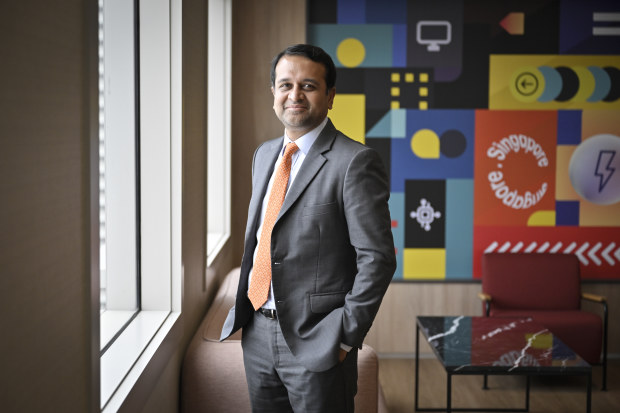China’s slowing economy is a headwind for Australian stocks, according to A$32 billion pension fund Brighter Super. Chief Investment Officer Mark Rider said his team recently pulled back on Aussie equities from about 27% of his firm’s default investment option to around 24.5%.
Meanwhile, ASX would be looking towards
* Westpac Consumer Sentiment (10:30 AEST today)
* Weighted mean CPI (11:30 AEST tomorrow)
The RBA may have not been serious enough to dampen local demand and spending so the fall in services inflation has not kept pace with international peers, suggesting that that opens some room for the RBA to hike as a policy choice.
Why the chances of a rate rise are higher than you think
Cecile LefortMarkets reporter
Jun 20, 2024 – 1.47pm
Traders are underestimating the threat of an interest rate rise in Australia after the Reserve Bank this week appeared increasingly worried about the stickiness of inflation, rate specialists warn.
While money markets have dialled up bets that borrowing costs could rise this year after governor Michele Bullock said the central bank had discussed the possibility, they only ascribe a 13 per cent chance.
“Bullock has been trying her best to soften the market up for a rate rise scenario, but looking at the overnight index swaps, it clearly hasn’t worked,” said Ben Picton, a senior strategist at Rabobank.
Prashant Newnaha at TD Securities says the Reserve Bank has laid the groundwork for potentially lifting the cash rate more than once. Caroline Chia
He, along with Warren Hogan at Judo Bank, are the only two economists calling for a rate increase. The vast majority predict the next rate move will be down, albeit not until late this year or early 2025.
Mr Picton said an unemployment rate below the full-employment level and still-too-high inflation suggest that monetary policy is on the “too-loose side” for the RBA to meet either its price stability or full-employment mandate.
“The logical policy response is to hike again,” he said.
Andrew Tilley, chief rate strategist at Barrenjoey, said markets should be pricing in a 60 per cent chance of a rate rise. “We should be pricing in 15 basis points of cuts by November this year against nearly zero at the moment.”
More importantly, he stressed that the market was underpricing the risk of several rate increases because 0.25 of a percentage point rise will lower inflation by just 0.1 percentage points over 18 months.
“A 25 basis point hike means you are just starting to step on the brake,” he said.
Prashant Newnaha, a macro strategist at TD Securities, also expects more than one increase, noting that the central bank has laid the groundwork for potentially lifting the cash rate to about 4.80 per cent.
“If the RBA does hike again, markets will price in some potential for a follow-up hike, but given its patience to maintain labour market gains, the odds should be around 30 to 40 per cent,” he said.
He noted that the RBA never ruled out lifting the cash rate again and this week’s statement went a step further implying “its patience on inflation is beginning to wear thin.”
Red flags
The RBA this week left the cash rate on hold at 4.35 per cent, as expected, for the seventh month, as it waits for the past 13 rate increases to filter through the economy and reduce pressure on prices.
But with the consumer price index at 3.6 per cent, well outside the RBA’s 2 per cent to 3 per cent target, and signs of it is drifting higher, next month’s June quarterly inflation report will be key for the path of interest rates.
Experts say an increase in core inflation of 1 per cent or above in the quarter will tip the central bank to lift the cash rate to 4.6 per cent. That has led some economists, including AMP and Betashares, to call the August 5-6 Reserve Bank meeting “live” to rates going higher.
Giulia Specchia, a rate strategist at UBS, said the market should imply a 40 per cent probability because the governor this week emphasised the next consumer price index print.
“It is important because she did something similar last year before hiking in November,” she said.
She is cautious about the prospect of further rate increases because of the uncertainty around other central banks. “If something breaks globally, then you could end up with many cuts priced in, that’s why markets have a neutral stance after August.”
The US Federal Reserve is expected to start easing rates in September or November and both the European Central Bank and the Bank of Canada lowered their benchmark earlier this month.
Robert Carnell, regional head of research at ING, noted that pressure to respond with higher rates had to be growing.
“If we see inflation rise again, we will think very hard about incorporating a rate hike in our forecasts,” he said.
Barrenjoey’s Mr Lilley also cautioned that the market was too optimistic about the prospect of rate cuts this year and next. Traders ascribe just a 10 per cent chance of an easing this year, from 65 per cent before the RBA meeting, and are fully priced for a cut in May 2025.
“If there is any rate move this year, it will be an increase,” he said.
TD Securities, Barrenjoey, and UBS predict that the next action from the RBA is an easing, albeit not until 2025.
- Forums
- ASX - General
- Its Over
China’s slowing economy is a headwind for Australian stocks,...
-
- There are more pages in this discussion • 274 more messages in this thread...
You’re viewing a single post only. To view the entire thread just sign in or Join Now (FREE)





